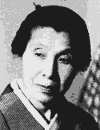Biography of Japanese Painter
Uemura Shoen (1875 - 1949)

Bijin-ga (Beautiful women painted in the Nihon-ga style) painter through the Meiji, Taisho and early Showa eras.
Shoen was born in Shimogyo ward of Kyoto city as the 2nd daughter of a
tea merchant whose shop name was "Chikiri-ya".
Her given name was Tsune.
Shoen is pseudonym.
Two months before of Shoen's birth, his father was died.
So, her mother Nakako grew up two daughters with difficulty.
As a child, Shoen exhibited considerable skill at drawing, though, people
at this era looked coldly at women depicting pictures.
Nakako was alway at Shoen's side and she protected her daughter.
Shoen lived in thankfulness to her mother throughout her lifetime.
In 1887, Shoen was sent to the Kyoto-Fu Ga-Gakko (Kyoto Prefectural Painting
School) at the age of 12.
However, she left school next year and became pupil of the Shijo style
painter Suzuki Shonen.
Suzuki Shonen was so impressed at Shoen's talent that he gave her the first
Kanji of his own pseudonym of "Sho".
In 1890, Shoen sent "Shiki-Bijin-Zu" to the 3rd Naikoku Kangyo
Exhibition and won the first prize.
Duke of Connaught, The Prince Arthur of England bought this painting so
that the name of Shoen became public.
In 1893, she became a pupil of Kohno Bairei.
In 1895, she became a pupil of Takeuchi Seiho as Bairei deceaced.
In 1902, she had a baby (Uemura Shoko) at the age of 27.
She never revealed his father's name, it is expected that his father was
her first teacher Suzuki Shonen.
She also had a love affair with her 3rd teacher Takeuchi Seiho.
Nevertheless, she made efforts to gain painting skills and received many
important prizes such as the Teiten and the Bunten Exhibitions.
She became judges of the Teiten, Shin-Bunten, Nitten Exhibitions and applied
for the New York World Expos.
Though, in her early 40s, she had a disappointment in love with younger
man, she fell into a slump.
From that experience, Shoen depicted a woman with deep jealousy whose work
name is "Honoh" (Flame) in 1918 when she was 43.
In 1934, her much-loved mother Nakako died.
Two years later (1936), Shoen brought out her representative work "Jo-no-Mai"
(=The picture above).
Shoen explained this painting that she wanted to express a woman that is
silent, sophisticated, sublime and brave, however, with a strong will.
She overlayed her mother's figure on the painting.
In 1948 (73 years old), she was awarded the Order of Cultural Merit at
the first time as a woman.
Shoen died in the next year (1949).






